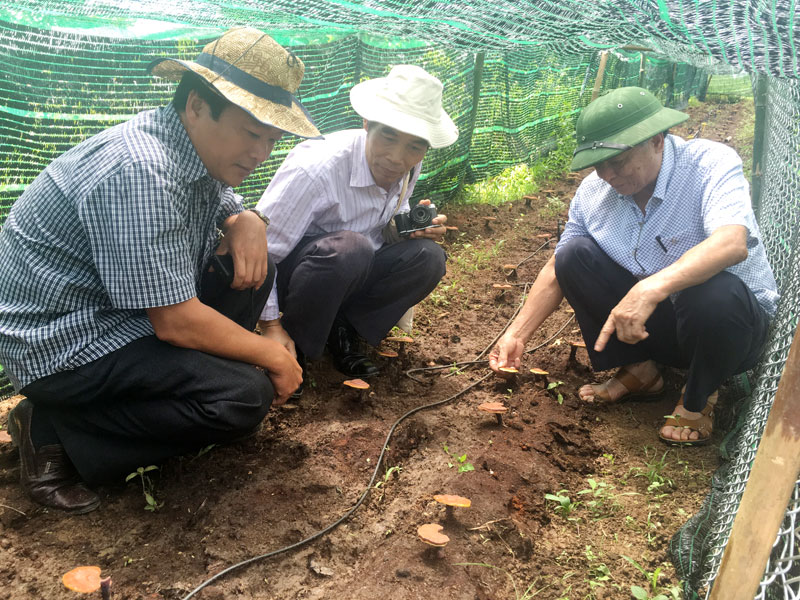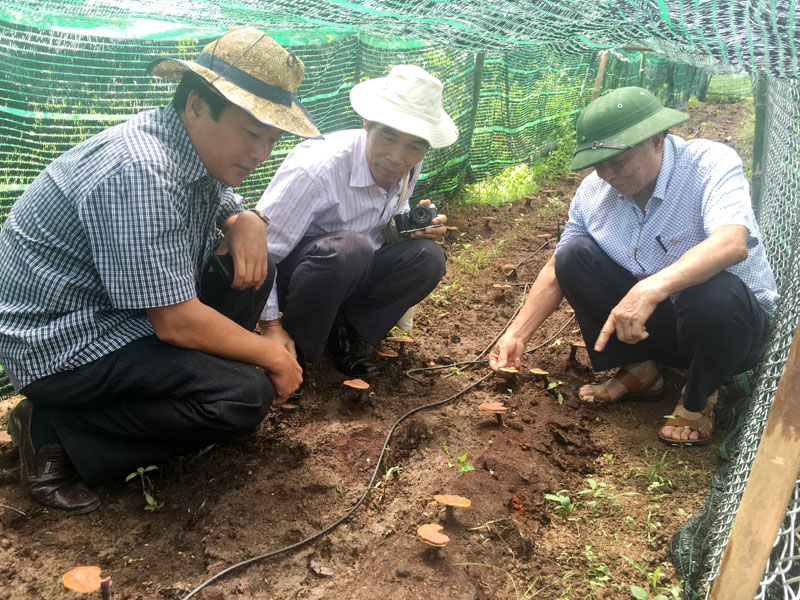
(HBO) – Lingzhi mushroom, a valuable medicinal herb, has been grown in some farms in Hoa Binh province, including the centre for scientific and technological application under the provincial Department of Science and Technology, and farms in Mong Hoa commune (Ky Son district) and Dong Tam commune (Lac Thuy district). Recently, Linh Dung organic farm in Dong Ngoai village, Vinh Tien commune (Kim Boi district) also cultivated the medicinal fungus on a trial basis. The farm has just harvested the first batch of lingzhi mushroom.

Photo: Linh Dung farm owner in
his red lingzhi garden which is ready for harvest
The owner of Linh Dung farm, PhD Nguyen Hong Yen, wants to popularise his
lingzhi mushroom which is cultivated using organic method. In fact, the
mushroom can only survive in natural and non-chemical environment. Any chemical
intervention from the grower can kill the plant.
Yen
said that there are six kinds of lingzhi mushrooms and the identification is
made based on their colour. He selected red lingzhi to plant on a trial basis
under the technical transfer of Nguyen Tien Ky from the institute of science
and technology research, training and counseling under the Vietnam Union of
Science and Technology Associations.
In
preparation for the garden, the grower had to prepare materials a couple of
months earlier (mostly in the outset of the year), dig ditches and raise beds
for the mushroom. Soil in the beds must be replaced by "lim” sawdust purchased
from wood logging businesses. The end of April was the most ideal time for spreading
substrate on the sawdust. After that, the substrate will be covered with
another layer of sawdust.
Notably, for successful testing plantation, the owner had to mix sawdust with lime
to prevent fungal infections before planting the mushroom. The mixture was made
from 20-30 kilogrammes of lime per one ton of sawdust. In an area of
300 square metresfor mushroom plantation, he used four tonnes of sawdust.
The technique is not that hard to follow, Yen affirmed, adding that it requires
suitable humidity for the mushroom to develop well, which should be maintained
at 80-90 percent in the air and around 60-70 percent inside the substrate. It
is also essential to use lime (calcium hydroxide) to treat sawdust in order to prevent
diseases for the mushroom.
With 1,000 mushroom kits supplied by the institute of
science and technology research, training and counseling, the Linh Dung Farm
had its first harvests at the end of June or 60 days after cultivating. After
the mushrooms were dried under sunlight for several days using quite
complicated methods, they were packed or steeped in wine. Yen said he has harvested
about
10 kgof dried lingzhi from the first crop, which fetched about 1.7 million VND per
kg. Yen has invested over 30 million VND to buy the 1,000 mushroom kits, so he
believed he would recover the investment on the second crop which will be ready
for harvest in a month. The mushroom can be harvested 4-5 times a year for a
period of at least 4-5 years.
Tests by the
Instituteof
Medicinal Materials in
HCM
Cityshowed lingzhi grown in the farm was free of harmful residues and bacteria.
The farm owner is brimming with hope, and plans to purchase
2,000 more lingzhi growing kits to expand production. At present, the farm does
not have enough mushrooms to sell.
According to data from the Hoa Binh Provincial Party Committee, the industrial production index for the first six months of 2025 is estimated to have increased by 20% compared to the same period last year. This marks the highest year-on-year growth rate for this period since 2020.
In the first six months of 2025, Hoa Binh province’s export turnover was estimated at 1.145 billion USD, marking an 18.11% increase compared to the same period in 2024. Import turnover was estimated at $ 804 million, a 17.15% increase, which helped the province maintain a positive trade balance.
The lives of the ethnic minority farmers in Tan Lac district have gradually improved thanks to the new directions in agricultural production. This is a testament to the collective strength fostered through the professional associations and groups implemented by various levels of the district’s Farmers’ Union.
With the motto the "product quality comes first,” after nearly one year of establishment and operation, Muong village’s Clean Food Agricultural and Commercial Cooperative, located in Cau Hamlet, Hung Son Commune (Kim Boi district), has launched reputable, high-quality agricultural products to the market that are well-received by consumers. The products such as Muong village’s pork sausage, salt-cured chicken, and salt-cured pork hocks have gradually carved out a place in the market and they are on the path to obtaining the OCOP certification.
In the past, the phrase "bumper harvest, rock-bottom prices" was a familiar refrain for Vietnamese farmers engaged in fragmented, small-scale agriculture. But today, a new spirit is emerging across rural areas of Hoa Binh province - one of collaboration, organisation, and collective economic models that provide a stable foundation for production.
Maintaining growing area codes and packing facility codes in accordance with regulations is a mandatory requirement for agricultural products to be eligible for export. Recently, the Department of Agriculture and Environment of Hoa Binh province has intensified technical supervision of designated farming areas and packing facilities to safeguard the "green passport" that enables its products to access international markets.



